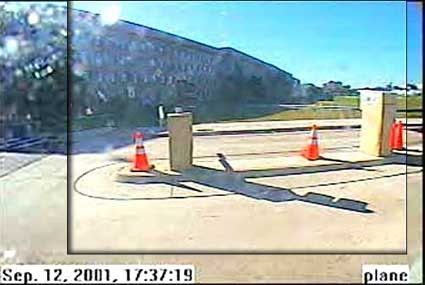THE UNLIKELY FINAL ALTITUDE
Adam Larson / Caustic Logic
The Frustrating Fraud
Last updated July 21 2007
Perhaps the strongest point still worth considering in the no-plane/Pentagon overflight argument is the suicide pilot’s precise attack, a feat of piloting some have flat-out called impossible for a jetliner, which would crash or fall apart or something under the pressure of what the expoerts call ground effect. Nila Segadevan, for example, found it evident "that it is physically impossible to fly a 200,000-lb airliner 20 feet above the ground at 400 MPH," and presumably even tougher to handle one as low as five feet or less and at speeds topping out at 575, as recorded in the FDR.
The attack craft’s performance as seen by the Washington controllers immediately raised eyebrows of suspicion. As the Washington Post reported the day after the attack how “just as the plane seemed to be on a suicide mission into the White House, the unidentified pilot executed a pivot so tight that it reminded observers of a fighter jet maneuver. The plane circled 270 degrees to the right to approach the Pentagon from the west, whereupon Flight 77 fell below radar level, vanishing from controllers’ screens.” Danielle O'Brien, an air controller at Dulles airport, told ABC News “the speed, the maneuverability, the way that he turned, we all thought in the radar room, all of us experienced air traffic controllers, that that was a military plane. You don't fly a 757 in that manner. It's unsafe.”
But safety apparently wasn’t the top concern; as he closed in, Hani Hanjour (we’re told) got even more bold and decided not to simply nose-dive his missile into the upper part of the fairly squat building (77 feet high in total) but to skim the ground like a hot rod even though it meant clipping light poles as he crossed a freeway (luckily no tall trucks there). In the last couple of hundred yards, he was reportedly flying only a few feet above the crew-cut lawn, and that with the wings wobbling under a deadly combo of high speed and atmospheric pressure, before slamming into the ground floor when he had five to choose from. Coming in so low means the engines would be nearly touching the ground, and any slight banking or upward irregularity in the surface would cause an engine to hit dirt and send the whole thing cart-wheeling into the lawn. Thus in addition to excellent control, Mr. Hanjour must have spent some time studying the exact topography of the Pentagon’s lawn to be sure it wouldn’t foil his daring precision approach with any pesky hillocks.
 |
So while the final approach may not be as perfect as widely believed, it is remrkable, and looks a bit like the work of a precision-guided missile. But after a look at the physical evidence and eyewitness accounts, it looks like a projectile the exact shape, size, weight, paint job, etc. of an American Airlines 757 or similar model. The plane may have had a long life of peaceful flights until re-rigged in its final days, and may well have been filled with the very people we were told it was. Captain Burlingame may well have been running the plane normally at takeoff as we’re told, but lost control as the plane turned around over Ohio, dropped its transponder signal, and closed communications with the outside world. This is far from provable, but well within the realm of possibility. Hani Hanjour, to put it mildly, is not the only pilot in the world who could pull all this off, and whoever or whatever was at the controls, it seems, knew the target very well.









No comments:
Post a Comment